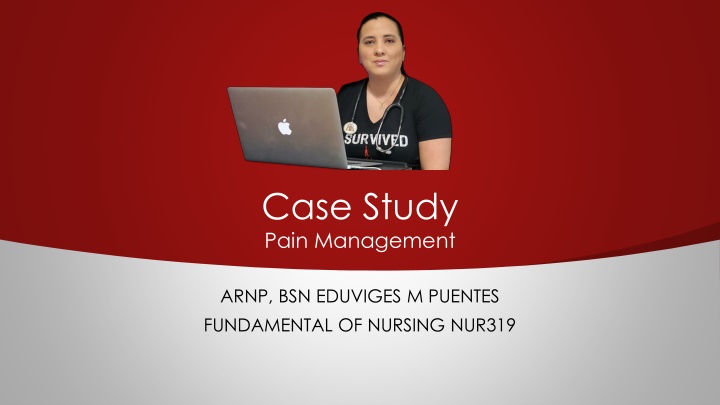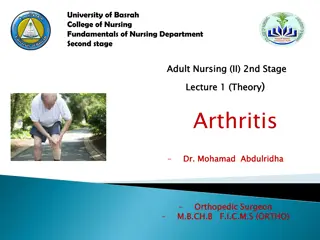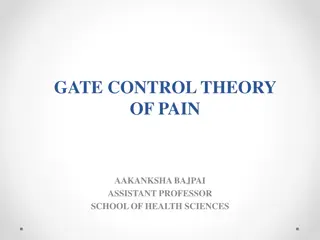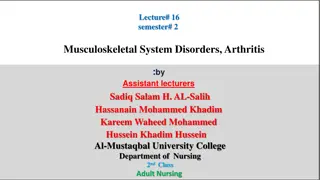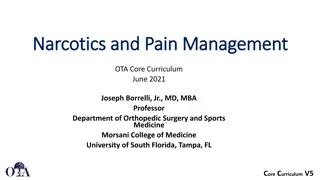Pain Management Case Study for Mrs. Ellis: Chronic Rheumatoid Arthritis
Mrs. Ellis, a 70-year-old African American woman, suffers from severe rheumatoid arthritis pain affecting her hands and feet, hindering her mobility and disrupting her daily life. Nursing student Jim is tasked to assess her pain and provide relief, facing challenges due to her chronic pain and limited support system.
Download Presentation

Please find below an Image/Link to download the presentation.
The content on the website is provided AS IS for your information and personal use only. It may not be sold, licensed, or shared on other websites without obtaining consent from the author.If you encounter any issues during the download, it is possible that the publisher has removed the file from their server.
You are allowed to download the files provided on this website for personal or commercial use, subject to the condition that they are used lawfully. All files are the property of their respective owners.
The content on the website is provided AS IS for your information and personal use only. It may not be sold, licensed, or shared on other websites without obtaining consent from the author.
E N D
Presentation Transcript
Case Study Pain Management ARNP, BSN EDUVIGES M PUENTES FUNDAMENTAL OF NURSING NUR319
Scenario Mrs. Ellis is a 70-year-old African American woman with hypertension, diabetes, and rheumatoid arthritis. Her current health priority is the discomfort and disability associated with her rheumatoid arthritis. Arthritis has severely deformed her hands and feet. The pain in her feet is so severe that she often walks only short distances. The pain interferes with sleep and reduces her energy both physically and emotionally. As a result, she does not leave home often.
1. Before meeting Mrs. Ellis, Jim needs to: Answer 1. Review the pain physiology of rheumatoid arthritis. 2. Prepare to conduct a pain assessment. 3. Draw upon previous experiences and interventions to relieve Mrs. Ellis pain. 4. Consider professional guidelines for chronic pain management. 5. Learn about support systems. 6. Respect personal and cultural meanings of pain.
Case Study (contd) Jim is a 26-year-old nursing student assigned to do home visits with the community health nurse. Jim knows that Mrs. Ellis has lived alone since her husband s death 6 years ago. Jim conducts assessments, performs procedures, and teaches health promotion to a variety of patients. This is Jim's first experience caring for a patient with severe chronic pain.
2. The assessment techniques Jim should perform are: Answer 1. Ask Mrs. Ellis to select a pain scale she prefers and rate her current pain intensity. 2. Ask Mrs. Ellis to rate her pain intensity when it is most severe. 3. Ask Mrs. Ellis what she does to control her pain. 4. Ask Mrs. Ellis if the pain medication is causing any side effects. 5. Observe Mrs. Ellis standing and walking to the kitchen. 6. Ask Mrs. Ellis if she has friends or neighbors to assist her.
Case Study (contd) When Jim enters Mrs. Ellis four-room apartment, he finds the home in disarray. Mrs. Ellis is sitting in a recliner in her living room, with clothing on the floor and soiled dishes on a nearby table. She reports that the pain she has been experiencing has made it very difficult to use her hands and walk between rooms. She is able to get to the bathroom, but it causes her to become fatigued. Her pain is constant and is localized in the joints of her hands and knees. Mrs. Ellis responses lead Jim to this nursing diagnosis: chronic pain related to joint inflammation. Mrs. Ellis has rated the pain as a 3 on a FACES Pain Scale of 0 to 10, with her most severe pain as a 4. She has been taking aspirin, but the pain prevents her from falling asleep; if she does sleep, she often reawakens. She has difficulty standing and an unsteady gait.
3. Goals for Mrs. Ellis Answer Mrs. Ellis will achieve a sense of pain relief within 1 week; she will ambulate with less discomfort on self- report within 14 days and perform activities of daily living with less discomfort within 14 days.
4. Expected outcomes for Mrs. Ellis are: Answer 1. Mrs. Ellis will report pain level of 2 on a FACES scale of 0 to 10 following relaxation therapy and heat application. 2. Mrs. Ellis will demonstrate the ability to rise to standing position without assistance within 1 week. 3. Mrs. Ellis will demonstrate the ability to walk from room to room using a walker with steady gait in 2 weeks. 4. Mrs. Ellis will be able to perform dishwashing and cleaning of house in 2 weeks.
